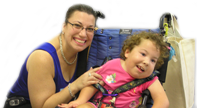Joseph Piven M.D.
Director; Professor of Psychiatry UNC Intellectual and Developmental Disabilities Research Center
UNC Intellectual and Developmental Disabilities Research CenterUniversity of North Carolina
UNC NDRC
130 Mason Farm Rd, CB# 3366
4123 Bioinformatics Building
Chapel Hill, NC 27599-3366
919-843-8641 (tel)
919-843-9955 (fax)
[email protected]
http://www.ndrc.unc.edu/
Biography/Curriculum Vitae:
Research Interests:
Dr. Joseph Piven's research focus is on the pathogenesis of autism including neural mechanisms, genetic basis and neuropsychological and behavioral phenotype.
Narrative of Current Research Efforts:
Collaborative Linkage Study of Autism
We previously reported evidence of linkage to a locus on chromosome 13 (D13S800) with a maximum multipoint heterogeneity lod score of 3.7; maximum lod scores > 2.0 on chromosomes 4 and 16; suggestive evidence of linkage to a region on chromosome 7 which has been recently reported to show linkage in other genome screens of autism published to date; and, several possible duplications and deletions in the q11-13 region of Chr 15, confirming other reports. In this 4-year granting period we are employing a variety of novel and complementary strategies (including varying phenotypic definition, family structures examined, and molecular and analytic approaches) available through the rich and varied expertise of our collaborative group of senior clinical, molecular and statistical genetics investigators, to resolve the genetic complexity of this disorder. Specifically we propose a series of studies to: 1) follow up the Stage 1 findings in 125 autistic sib pairs families; 2) repeat these analyses of the nuclear (sib pair) families, adding in information on the Pervasive Developmental Disorder (PDD) and broader autism (BAP) phenotypes in first-degree relatives without autism; 3) conduct a linkage study of autism, as well as a study of the PDD/BAP phenotype, in a number of extended pedigrees; and, 4) examine the prevalence of Chr. 15 duplications/deletions in autism, and a large group of controls.
STAART Center Project 1: The Neuropsychological Basis of the Broad Autism Phenotype
For over 15 years our research team and others have taken Kanner’s original observations about personality features characteristic of some parents of autistic individuals and developed definitions of, and standardized measures for, a broader autism phenotype. The broad autism phenotype (BAP) is thought to represent the phenotypic expression of the genetic liability to autism in non-autistic relatives of autistic probands, and is defined by characteristics that are milder but qualitatively similar to the defining features of autism. While autism and the BAP are defined by particular behavioral characteristics, they are clinically and etiologically heterogeneous, and are the end result of a range of underlying neuropsychological, neural and genetic mechanisms. In this project we propose to examine the high-functioning autistic and Down syndrome adolescent and adult probands, and their first-degree relatives, on selected neuropsychological measures of social cognition, central coherence and executive function, three principal cognitive frameworks proposed as theories to explain the neuropsychological basis of autism. These neuropsychological characteristics will be examined in relationship to our clinically-based measures of the BAP, in order to both elucidate the neuropsychological basis of the BAP and to provide efficient, valid and reliable measures for future studies of the BAP. Autism and DS relatives will be compared in these three neuropsychological domains, to a unique sample of individuals with focal brain lesions in the amygdala, orbital-frontal cortex and right somatosensory cortex, drawn from a brain injury registry at the University of Iowa, to provide insights into the neural basis of the behavioral and neuropsychological characteristics of autism and the BAP. Finally, patterns of co-occurrence of these characteristics will be examined in individuals and families. This project brings together a unique group of experienced researchers with complementary expertise in family-genetic (J. Piven) and neuropsychological studies of autism (F. Happé), and in the neural basis of social cognition (R. Adolphs), to study the neuropsychological basis of the broad autism phenotype.
Major Honors and Awards:
Representative Publications:
Created 8/20/2005 by
Last modified 12/13/2010 by Oksana Klimova







